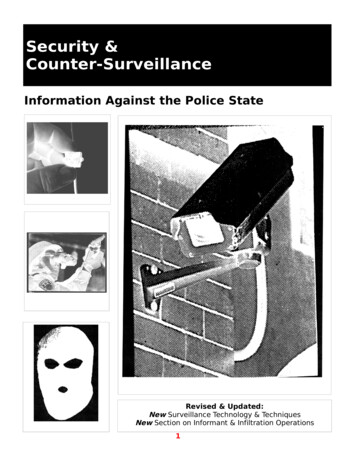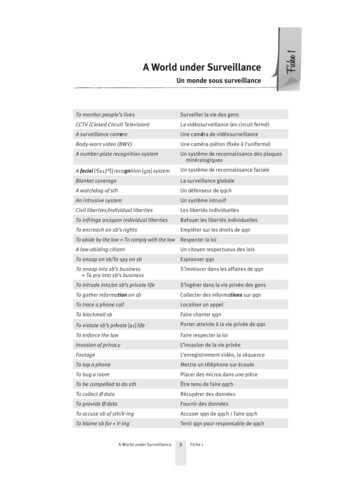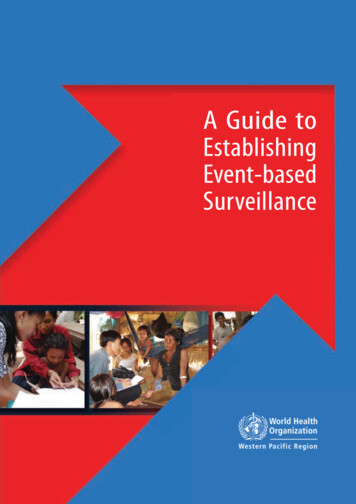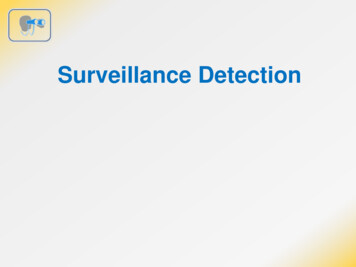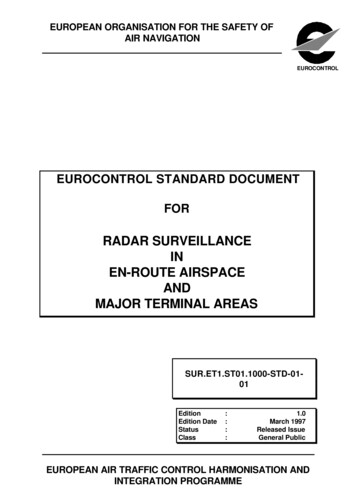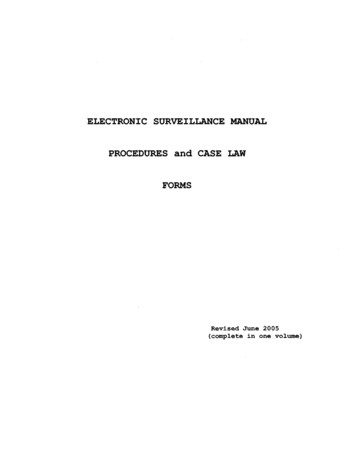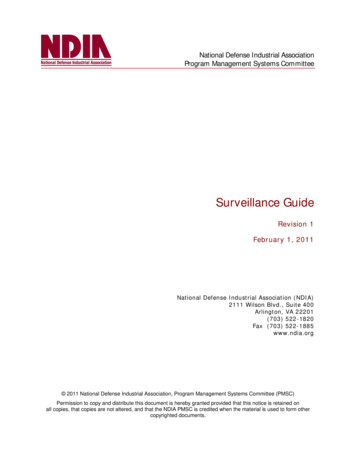
Transcription
National Defense Industrial AssociationProgram Management Systems CommitteeSurveillance GuideRevision 1February 1, 2011National Defense Industrial Association (NDIA)2111 Wilson Blvd., Suite 400Arlington, VA 22201(703) 522-1820Fax (703) 522-1885www.ndia.org 2011 National Defense Industrial Association, Program Management Systems Committee (PMSC)Permission to copy and distribute this document is hereby granted provided that this notice is retained onall copies, that copies are not altered, and that the NDIA PMSC is credited when the material is used to form othercopyrighted documents.
Surveillance GuideTable of Contents1Introduction . 11.1 Surveillance Overview . 11.2 Purpose of the Guide . 11.3 Definitions . 22Establishing the Surveillance Team Roles and Responsibilities . 42.1 Establish the Surveillance Team . 42.2 Define the Surveillance Team Roles and Responsibilities . 42.3 Identify the Surveillance Team Members . 43Annual Surveillance Planning . 53.1 The Surveillance Approach . 53.2 Process and Guideline Selection . 53.3 Annual Project Schedule and Selection . 64Project Surveillance Planning .104.1 Team Member Assignment .104.2 Project Surveillance Planning .115Conducting the Surveillance Review .135.1 Introduction .135.2 Surveillance Execution .145.2.1Responsibilities .145.2.2Project Information .145.2.3Orientation .155.2.4Data Gathering.155.2.5Feedback .165.2.6Subcontractor Surveillance .165.3 Surveillance Results .185.3.1Disposition of Team Assessments .185.3.2Reporting Surveillance Results .205.3.3Corrective Action Plan Closure and Verification . 206System Surveillance Results .206.1 Overview.206.2 Tracking Project Surveillance Results .206.3 Metrics .216.3.1System Level Surveillance .216.3.2Annual Review .22 2011 NDIA PMSCi
Surveillance GuideList of AcronymsANSIAmerican National Standards InstituteBOEBasis of EstimateBOMBill of MaterialCAControl AccountCAMControl Account ManagerCAPCorrective Action PlanCARCorrective Action RequestCBBContract Budget BaseCCDRContract Cost Data ReportCDRLContract Data Requirements ListCFACognizant Federal AgencyCFSRContract Funds Status ReportCPRContract Performance ReportCWBSContract Work Breakdown StructureCVCost VarianceDCAADefense Contract Audit AgencyDCMADefense Contract Management AgencyDoDDepartment of DefenseEACEstimate at CompletionEIAElectronic Industries AllianceETCEstimate to CompleteEVMEarned Value ManagementEVMSEarned Value Management SystemGAOGovernment Accountability OfficeGEIAGovernment Electronics and Information Technology AssociationIBRIntegrated Baseline ReviewIMSIntegrated Master ScheduleIOTInterorganizational TransfersJSRJoint Surveillance ReviewLOELevel of EffortMRManagement ReserveNDIANational Defense Industrial Association 2011 NDIA PMSCii
Surveillance GuideOBSOrganization Breakdown StructurePMProject ManagerPMBPerformance Measurement BaselinePMSCProgram Management Systems CommitteeQBDQuantifiable Backup DataRAMResponsibility Assignment MatrixSDDSystem Description DocumentSOWStatement of WorkSVSchedule VarianceUBUndistributed BudgetVACVariance at CompleteWBSWork Breakdown Structure 2011 NDIA PMSCiii
Surveillance Guide1 Introduction1.1 Surveillance OverviewSurveillance is the continuous process of reviewing the health of the earned value managementsystem (EVMS) as applied to one or more projects. The purpose of surveillance is to ensurethe EVMS is effectively used to manage cost, schedule, and technical performance, and that theperformance data generated are accurate and reliable. An effective surveillance processensures that the key elements of the system are maintained over time and on subsequentapplications.A surveillance plan is established to meet the goals of surveillance, which are: To ensure that the organization’s EVMS processes and procedures have beeneffectively implemented in accordance with the organization’s EVMS description andsupplemental procedures and program instructions. To ensure the EVMS provides timely, accurate, and reliable project managementinformation for internal and customer use. To assess the organization’s commitment and ability to use its EVMS as an integral partof its management process.Surveillance generally starts once an EVMS is fully implemented on a newly awarded contract,continues through acceptance (if the EVMS has not been previously accepted) 1 , and extendsthrough the duration of the contract. It should not be confused with Integrated BaselineReviews (IBR) as these are specific programmatic events focused on project risk, as well as theadequacy and executability of the project’s performance measurement baseline (PMB).However, the results of the surveillance process may be used by IBR teams to provide insightinto the health of the EVMS for the purpose of assessing management risk.In addition, a well executed surveillance process will provide insight for continuous improvementand innovation of the EVMS and provide for effective communication of observed noncompliance.An overview of the surveillance process includes: Establishing the surveillance team roles and responsibilities Planning Execution Documentation and communication of results Corrective action and process improvement1.2 Purpose of the GuideThis document provides surveillance process guidance and characteristics of successful EVMSsurveillance programs. It is intended to assist suppliers in the planning and execution of both1In situations where the organization’s EVMS has not been previously accepted, the customer mustreview the proposed EVMS plan and determine that it meets the intent of ANSI/EIA 748 (current version).Once that determination has been made and the proposed EVMS is implemented, surveillance isconducted against the proposed EVMS until the acceptance review occurs. Once accepted, surveillanceis performed against the accepted EVMS. 2011 NDIA PMSC1
Surveillance Guideinternal surveillance and subcontractor surveillance, and to provide guidance for non-DoDorganizations with EVMS oversight responsibility. Suppliers planning their internal andsubcontractor surveillance programs should refer to the latest customer surveillance guidance,for information on how the customer plans and conducts EVMS surveillance, to enable bettercoordination of their internal, subcontractor, and joint surveillance planning.A standardized approach to effective surveillance benefits all parties because it ensures acommon understanding of expectations, encourages efficiencies through the use of a uniformprocess, and gives consistent guidance to organizations responsible for EVMS surveillance, aswell as those who are in the process of implementing an EVMS that meets the intent of theANSI/EIA 748 (current version) Standard for Earned Value Management Systems. This NDIAPMSC Surveillance Guide is recommended for use by all stakeholders in the EVMS process.An organization implementing EVMS for the first time may use this guide as a model forestablishing a cost effective EVMS surveillance process. Until an EVMS acceptance isobtained, surveillance is conducted on one or more projects using the EVMS proposed for useby the organization. Thereafter, surveillance is conducted on the implementation of theaccepted EVMS. This guide can also be used by companies that are seeking to make internaland subcontractor EVMS surveillance more effective and to standardize joint surveillanceapproaches with their non-DoD customers.1.3 DefinitionsAccepted EVMSAn earned value management system (EVMS), which has beendetermined to meet the intent of the guidelines found in ANSI/EIA748 (current version). Synonymous terms include validated EVMS,certified EVMS, and approved EVMS. Cognizant Federal Agenciesdocument EVMS acceptance using an advance agreement, letter ofacceptance, or similar document. Acceptance may be applicable toan EVMS used at a single geographic location or in multiplelocations. Please refer to the NDIA PMSC Acceptance Guide forfurther information and for system acceptance guidance.CustomerThe entity, either internal to an organization or external to it, forwhich one or more projects are being executed. Typically, theexternal customer is the Government or a prime contractor.EVMSAn integrated set of processes, people and tools for managingprojects using earned value management, which conforms to theguidelines found in ANSI/EIA 748 (current version).EVMS GuidelinesThe 32 EVMS guidelines contained in ANSI/EIA 748 (currentversion).Joint SurveillanceProject surveillance conducted jointly by the supplier and customer.OrganizationA customer or supplier entity, including agencies responsible formanagement of internal projects using EVMS, prime contractors,subcontractors and interorganizational transfers (IOT), with EVMSownership and oversight responsibility for one or more sites. 2011 NDIA PMSC2
Surveillance GuidePerformanceMeasurement Baseline(PMB)The budget at completion (BAC) which, when time phased,establishes the PMB against which project performance is measured.It is the schedule for expenditure of the resources allocated toaccomplish project scope and schedule objectives, and is formed bythe budgets assigned to control accounts and applicable indirectbudgets. The PMB also includes budget for future effort assigned tohigher work breakdown structure (WBS) levels (summary levelplanning packages) plus any undistributed budget. Managementreserve is not included in the PMB as it is not yet designated forspecific work scope.ProgramA major, independent part of a capital asset or system that involvesa planned effort to achieve an outcome, the progress toward whichis discretely measurable. A program may be comprised of multipleprojects, delivery orders, task orders, or other recognized termsindicating a bilateral agreement between contracting parties.ProjectA project has defined technical scope, schedule, and cost.Generally, a project comprises all effort authorized by a contract orother authorization document received from a customer, e.g., asubcontract or IOT, but it may also be an internally defined andauthorized effort. There may be multiple projects within a program.Project SurveillanceThe process of reviewing an individual project’s implementation ofthe organization’s accepted EVMS processes.SupplierAn entity, either internal to an organization or external to it, fromwhich goods or services are required to complete a project.Suppliers include prime contractors, subcontractors or sub-tiercontractors, as well as interorganizational transfers (IOTs), whichare responsible for project execution using EVMS.Surveillance PlanAn annual plan that identifies the projects to be included insurveillance reviews, as well as the frequency and scope of theindividual surveillance visits planned for each project included in theannual plan.Surveillance ProgramA surveillance program comprises an organization’s people,processes, tools, and training necessary to execute internal andsubcontractor surveillance, independent of customer surveillanceactivities or requirements, for the purpose of ensuring that itsprojects are effectively managed to meet their cost, schedule, andtechnical objectives.System SurveillanceCross-project EVMS surveillance is used to assess an organization’scapability to consistently implement and use its accepted EVMS onall projects with EVMS requirements. Cross-project EVMSsurveillance is also known as system surveillance, because it canidentify findings common to multiple projects, which are indicative ofsystemic problems. 2011 NDIA PMSC3
Surveillance GuideSystem surveillance therefore comprises a summarization of multiproject surveillance results rather than a separate system levelsurveillance review.2 Establishing the Surveillance Team Roles and ResponsibilitiesFor effective assessment of ongoing compliance with the accepted EVMS, a team must beidentified and assigned authority and accountability for EVMS surveillance. Responsibilityshould be assigned to individuals who are independent of the projects they will be assigned tooversee and have the necessary experience to effectively evaluate the EVMS as defined below.This recommendation applies whether the team members are employees or acquired fromexternal sources, e.g., professional service providers (consultants).2.1 Establish the Surveillance TeamThe first step in establishing a surveillance team with these characteristics is to identify theinternal organization that will be assigned responsibility and authority for staffing and overseeingthe surveillance team. Since authority and independence are critical characteristics of thisteam, it must report independently of the management chain responsible for the projects thatthe surveillance team will be reviewing. Independence ensures that findings will be objectiveand that systemic issues on multiple projects will be identified. This will ensure that theorganization maintains an effective EVMS, which enables its project managers to achieve betterproject outcomes. The surveillance team assigned responsibility for the EVMS surveillanceprocess must also have sufficient authority to concur on the resolution of issues and findings.2.2 Define the Surveillance Team Roles and ResponsibilitiesThe second step is to define the surveillance team’s charter and authority via organizationpolicy. The charter documents the team’s role, responsibilities, dispute resolution process, andmembership requirements. A single individual is designated as the owner of the EVMSsurveillance process and may be the same as the process owner of the EVMS. Thesurveillance team members require clear authority, responsibility, and accountability for theexecution of the surveillance program, which uses this process.Responsibilities of the surveillance team include: Developing an annual surveillance plan and approach. Appointing a team leader for project surveillance reviews. Assigning resources to the surveillance reviews. Documenting and communicating the results of the surveillance. Concurring with the corrective action plans proposed by the projects. Tracking corrective actions to closure. Developing and maintaining surveillance databases and metrics to assess the systemichealth of the process, as demonstrated across multiple reviews.2.3 Identify the Surveillance Team MembersThe third step is to staff the team responsible for surveillance in a manner that is consistent withits chartered responsibilities. An effective staff has the following key attributes: 2011 NDIA PMSC4
Surveillance Guide Multiple-disciplinary knowledge and experience. Knowledge of the EVMS in use at the site/project subject to surveillance. Practical experience using EVMS. Ability to develop/maintain good working relationships with external and internalcustomers and suppliers. Independent of the program or project under surveillance.The surveillance team is responsible for surveillance reviews across multiple projects. Multipledisciplinary knowledge and experience, including practical experience using EVM, is crucial tounderstand the dynamics of effective implementation across a diverse set of projects. It alsoenables the team to have a comprehensive perspective of the overall process, develop lessonslearned, and recommend successful practices.Members of the surveillance team must be knowledgeable and experienced with the processesdefined by the organization’s EVMS documentation. Understanding the relationship of theEVMS guidelines to organization processes is vital to ensuring that unforeseen loopholes inorganization processes do not allow informal practices that conflict with the intent of the EVMSguidelines. It also allows the project’s implementation to be tested against the accepted EVMSrather than directly against the guidelines in ANSI/EIA 748 (current version).Understanding both customer and internal perspectives is also important. Effectivecommunication may involve bringing both perspectives together, managing expectations, andensuring that a logical, practical project implementation can be accomplished in accordancewith the requirements of the accepted EVMS. In addition, members of the surveillance teammust be able to effectively communicate the impact of any issues of non-compliance to theproject team, as well as to appropriate customer and/or internal management.3 Annual Surveillance Planning3.1 The Surveillance ApproachAn organization’s surveillance approach is typically documented in a surveillance processdescription or procedure. The surveillance procedure is supplemented by a surveillance plancontaining the projects and subcontractors, as applicable, which have been selected forsurveillance during a timeframe driven by the organization needs/requirements.3.2 Process and Guideline SelectionAll aspects of the EVMS are considered when selecting EVM processes for surveillance.Comprehensive surveillance addresses the full content of the organization’s EVMS descriptionand may rely on the results of other related reviews as well, for example, supplier systems aresometimes subject to periodic reviews by internal audit or customer auditing organizations suchas DCMA, DCAA and GAO. These organizations may audit associated business systems, forexample the procurement, accounting, and material systems, which are referenced in theANSI/EIA 748 (current version). If so, those processes may be excluded from the surveillanceplan to avoid duplication of effort. However relevant findings from those related audits must beconsidered by the surveillance team in assessing the overall health of the EVMS. For example,if a procurement system review finding reveals that material receipts are not handled correctly,the surveillance team must assess the impact on the EVMS and review the corrective action to 2011 NDIA PMSC5
Surveillance Guideensure it will meet the requirements of the accepted EVMS or, if an EVMS change is needed, toensure it will meet the intent of the guidelines in the ANSI/EIA 748 (current version).EVMS surveillance planning is typically done annually, with an overall goal of reviewing all EVMprocesses over the course of a year to ensure they are implemented and used in accordancewith the accepted EVMS, as documented in the organization’s EVMS description and relatedprocedures. However, the frequency and content of surveillance may vary based onapplicability of the processes to the organization’s portfolio of projects, assessed risk, andcustomer concerns. The surveillance plan should allow flexibility in the timing of scheduledreviews to avoid disruption of key project events, as well as appropriate matching of processreviews with project requirements and phases. The surveillance planning objective should be toselect processes for review based upon the risk associated with the remaining work on theprojects being reviewed. The selection of EVM guidelines/processes reviewed should berelevant to the project phase and provide an opportunity for coaching or mentoring during theprocess review as discussed in the following examples.Example 1:A surveillance review of the process for change control would be appropriate ona project experiencing frequent contractual changes or on a project that recentlyincorporated a new baseline, whereas, it may not be appropriate on a newproject, where baseline changes have not yet occurred. However, a new projectwould be an excellent candidate for review of the implementation and use of theplanning and work authorization processes.Example 2:A surveillance review of the process for determining an estimate at completion(EAC), and its compliance with the accepted EVMS, would generally bebeneficial on a development project in which the dynamics of technology couldbe driving EAC trends higher. Conversely, an EAC process review of a follow-onproduction project in which the performance reflects trends that are stable, wouldconfirm appropriate process implementation but add little value for the projectitself.Example 3:When selecting the projects to be reviewed for a particular process or guideline,the project’s requirements and phase should be considered. For example, whentesting the work authorization process, it may not be appropriate to select aproject which is near completion. Similarly, selecting a project to review thematerial or subcontractor management process would require that these projectelements be present.3.3 Annual Project Schedule and SelectionThe annual project selection process is initiated by reviewing a list of all potential candidateprojects. From this list, projects are selected for surveillance based upon the risk assessed fortheir content and remaining work. These selection criteria allow the surveillance process toprovide value added benefits to the project, as well as to the organization. In making theselection, all aspects of risk are considered, including: Cost Schedule Technical, e.g., requirements definition, availability of technology, design maturity,maturity of technical capabilities, etc. Resources Management 2011 NDIA PMSC6
Surveillance Guide Project size and complexity Project phase Percent complete Nature of remaining work Number and dollar value of subcontractors Past performance Customer concerns Project and site management interest or concernsDue to this broad scope, as well as to the number and mix of contracts and their inherent risk, itmay not be necessary or feasible to review all 32 EVMS guidelines annually on all contracts.The surveillance planning process should ensure the review of all 32 guidelines in connectionwith the implementation and use of a accepted EVMS on a cycle appropriate to the EVMSprocess maturity and risk as determined by the results of previous surveillance. For example,lack of significant findings in previous surveillance reviews may indicate that less frequent orless comprehensive surveillance is sufficient and, in addition, more cost effective. Surveillancefrequency and scope may also vary from project to project depending on individual contractscope, content, and risk.Other factors influencing the risk assessment and the selection of projects for surveillanceinclude: the maturity of the EVMS processes, the experience of the project team, the number ofprojects at the site, and the resources available to the surveillance team. When jointsurveillance is required, internal surveillance planning should be coordinated with jointsurveillance planning to avoid duplication of effort and minimize project disruption.One approach to selecting projects for annual surveillance is to assess project risk using analgorithm (for an example see Table 3.3) that assigns relative weights and severity to eachapplicable risk area. Assessing risk associated with the following factors, on a project by projectbasis, provides a basis for prioritizing the EVM processes for review and for selecting theprojects to be included in the surveillance plan. Contract value. The contract value is viewed in relative terms for the organization. Highdollar value contracts are often considered appropriate candidates for frequent EVMsurveillance. Current or cumulative cost or schedule variances or projected variances at completion.Projects experiencing or forecasting difficulty maintaining cost and/or schedule controlare generally reviewed more frequently. Problems found in organization or baselineplanning may provide valuable insight to implement effective corrective action. Baseline resets. The frequency of baseline resets (especially when accompanied byelimination of cumulative cost and/or schedule variances) may be indicative of a numberof situations: poor original baseline planning, a change in work approach, make or buydeterminations, and/or significant schedule/technical changes. Projects reflecting asignificant number of baseline resets are generally appropriate candidates for frequentsurveillance associated with their change control and EAC processes. Baseline resetsaffect the reliability of the earned value data and may be used as a trigger forsurveillance. 2011 NDIA PMSC7
Surveillance Guide Nature of remaining work. The technical content of remaining work is reviewed toascertain the level of performance risks remaining on the contract. Volume or amount of work remaining. Performing surveillance on contracts nearingcompletion provides little opportunity to improve the remaining work and adds no valueto the project, but it may provide a wealth of insight on newly begun or future efforts. Phase and type of contract. Development contracts are generally considered to behigher risk and are frequently considered candidates for surveillance. Production orfollow-on contracts are typically considered lower risk. The contract type alsodetermines who has more risk, the customer or the organization. A firm fixed pricecontract poses more potential risk for the organization than it does for the customer and,therefore, such contracts would be candidates for more frequent internal surveillance. Itis also important to realize, in assessing risk, that risk may change over the life of acontract. For example, the transition from a development phase to an operations andmaintenance phase within a single contract will be accompanied by a correspondingdecrease in the project’s level of risk. Historical trends. Experience of organization project office. The project office’s experience withimplementing and using EVM processes may influence the selection of projects forsurveillance. The lack of experience with EVM in the project office’s personnel mightallow project baseline planning to be accomplished without following documentedprocesses or procedures, thereby increasing the risk of poor applications with unreliableproject data. Conversely, the expectation for those project offices that are experiencedwith EVM would be that appropriate EVM project applications and data use wouldproduce reliable data and project reporting, thus lowering project risk. Time since last review. The length of time since the last review of EVMS processes maybe used to determine the frequency of surveillance. Management interest, project importance. Highly visible and important projects willalways be of interest to management, especially when the information indicates risk orissues regarding project performance. However, even when the indications are that aproject is performing well, a consideration for including the project may be to identifybest practices that could be applied to other projects. Risk and opportunity assessment. The maturity/health of the risk management process,including the quality of the risk assessment and the related risk and opportunity handlingplans; the extent of risk and opportunity management integration with EVMS, whichindicates whether the PMB includes scheduled risk mitigation and opportunity captureactivities along with budget assigned for their execution, as well as the means of trackingthe progress on these activities using EVM; and adequate management reserves toprospectively address risks/opportunities not included in the PMB, are all indications of awell managed project . Projects lacking in these areas are candidates for clos
National Defense Industrial Association . Program Management Systems Committee . Surveillance Guide . Revision 1 . February 1, 2011 . National Defense Industrial Association (NDIA)




